Identification and Spatiotemporal Analysis of Bikesharing-Metro Integration Cycling
Abstract
:1. Introduction
2. Related Work
3. Study Area and Data Sources
3.1. Study Area
3.2. Data Sources and Preprocessing
4. Research Methods
4.1. Overall Idea
4.2. DBsMIC Identification Method
4.2.1. Candidate POI Identification
4.2.2. Candidate POI Attractiveness Evaluation
- Calculate the distance decay weighted supply/demand ratio for parking points. For a parking point S((x,y),t), its walkable distance (CWD) is divided into four sub-regions d1, d2, d3, and d4 with radii of 0–20 m, 20–50 m, 50–100 m, and 100–200 m respectively, and then all candidate POIs within each sub-region are identified and the weighted supply–demand ratio RS of the parking point S is calculated with the following equation.
- 2.
- Calculate the candidate POI attractiveness. For the candidate POI PS,i, all parking points in different sub-regions within its 200 m range are determined, and the RS of all parking points in the sub-region are aggregated and multiplied by the distance weight and the service power index SCtype of that POI to obtain the self-attractiveness APS,i of PS,i, which is calculated as follows.
- 3.
- Calculate the attractiveness of the candidate POI to the parking point. The final candidate POI attractiveness assessment model G(S,PS,i) for parking point S is obtained by substituting APS,i into the basic gravity model with the following equation.
4.2.3. Candidate POI Access Probability Calculation
4.3. Spatiotemporal Characteristic Analysis Method of the DBsMIC
5. Results
5.1. Analysis of the Results of the DBsMIC Recognition
5.2. Analysis of the Spatiotemporal Characteristics of DBsMIC
5.2.1. Cycling Behavioral Characteristics
- 1.
- Overall Cycling Behavioral Characteristics
- 2.
- Riding Volume Time Characteristics
5.2.2. Analysis of the Spatiotemporal Characteristics of Cycling
- Overall Spatiotemporal Cycling Characteristics
- 2.
- Spatiotemporal Characteristics of Cycling on Working Days and Rest Days
- 3.
- Spatiotemporal Characteristics of Cycling in and out of the Station during the Morning and Evening Peaks on Weekdays
6. Discussion and Conclusions
6.1. Discussion
6.2. Conclusions
Author Contributions
Funding
Institutional Review Board Statement
Informed Consent Statement
Data Availability Statement
Acknowledgments
Conflicts of Interest
References
- Sodiq, A.; Baloch, A.A.B.; Khan, S.A.; Sezer, N.; Mahmoud, S.; Jama, M.; Abdelaal, A. Towards Modern Sustainable Cities: Review of Sustainability Principles and Trends. J. Clean. Prod. 2019, 227, 972–1001. [Google Scholar] [CrossRef]
- Rafael, S.; Correia, L.P.; Lopes, D.; Bandeira, J.; Coelho, M.C.; Andrade, M.; Borrego, C.; Miranda, A.I. Autonomous Vehicles Opportunities for Cities Air Quality. Sci. Total Environ. 2020, 712, 136546. [Google Scholar] [CrossRef]
- Zhang, S.; Chen, L.; Li, Y. Shared Bicycle Distribution Connected to Subway Line Considering Citizens’ Morning Peak Social Characteristics for Urban Low-Carbon Development. Sustainability 2021, 13, 9263. [Google Scholar] [CrossRef]
- Guo, D.; Yao, E.; Liu, S.; Chen, R.; Hong, J.; Zhang, J. Exploring the Role of Passengers’ Attitude in the Integration of Dockless Bike-Sharing and Public Transit: A Hybrid Choice Modeling Approach. J. Clean. Prod. 2023, 384, 135627. [Google Scholar] [CrossRef]
- Cheng, L.; Wang, K.; De Vos, J.; Huang, J.; Witlox, F. Exploring Non-Linear Built Environment Effects on the Integration of Free-Floating Bike-Share and Urban Rail Transport: A Quantile Regression Approach. Transp. Res. Part Policy Pract. 2022, 162, 175–187. [Google Scholar] [CrossRef]
- OFO. 2017 Shanghai Metro 1 km of Shared Bicycle Travel Data Report [EB/OL]. Available online: http://wap.xinmin.cn/content/31338639.html (accessed on 2 February 2022). (In Chinese).
- Chu, J.; Duan, Y.; Yang, X.; Wang, L. The Last Mile Matters: Impact of Dockless Bike Sharing on Subway Housing Price Premium. Manag. Sci. 2021, 67, 297–316. [Google Scholar] [CrossRef]
- Liouta, G.; Saibene, G.; van Oort, N.; Cats, O.; Schulte, F. Can Shared Mobility Compensate for Public Transport Disruptions? The Case of Milan’s Bike Sharing System During the COVID-19 Pandemic. Transp. Res. Rec. 2022, 03611981221123241. [Google Scholar] [CrossRef]
- Liu, S.; Zhou, C.; Rong, J.; Bian, Y.; Wang, Y. Concordance between Regional Functions and Mobility Features Using Bike-Sharing and Land-Use Data near Metro Stations. Sustain. Cities Soc. 2022, 84, 104010. [Google Scholar] [CrossRef]
- Fan, Y.; Zheng, S. Dockless Bike Sharing Alleviates Road Congestion by Complementing Subway Travel: Evidence from Beijing. Cities 2020, 107, 102895. [Google Scholar] [CrossRef]
- Cheng, L.; Huang, J.; Jin, T.; Chen, W.; Li, A.; Witlox, F. Comparison of Station-Based and Free-Floating Bikeshare Systems as Feeder Modes to the Metro. J. Transp. Geogr. 2023, 107, 103545. [Google Scholar] [CrossRef]
- Ni, Y.; Chen, J. Exploring the Effects of the Built Environment on Two Transfer Modes for Metros: Dockless Bike Sharing and Taxis. Sustainability 2020, 12, 2034. [Google Scholar] [CrossRef] [Green Version]
- Chen, W.; Chen, X.; Chen, J.; Cheng, L. What Factors Influence Ridership of Station-Based Bike Sharing and Free-Floating Bike Sharing at Rail Transit Stations? Int. J. Sustain. Transp. 2022, 16, 357–373. [Google Scholar] [CrossRef]
- Cao, J.; Prior, J.; Giurco, D. Government and Private Company Collaboration in the Governance of Shared Mobility Schemes: A Case Study of Dockless Bike-Sharing Schemes in Sydney, Australia. Sustainability 2022, 14, 13141. [Google Scholar] [CrossRef]
- Mooney, S.J.; Hosford, K.; Howe, B.; Yan, A.; Winters, M.; Bassok, A.; Hirsch, J.A. Freedom from the station: Spatial equity in access to dockless bike share. J. Transp. Geogr. 2019, 74, 91–96. [Google Scholar] [CrossRef]
- Yun, M.; Wei, S.; Ma, Y. The Impact of Dockless Bike-Sharing on Public Transit: A Case Study of Shanghai, China. In Proceedings of the 21st COTA International Conference of Transportation, Beijing, China, 14–17 July 2021; pp. 955–965. [Google Scholar] [CrossRef]
- Lv, Y.; Zhi, D.; Sun, H.; Qi, G. Mobility Pattern Recognition Based Prediction for the Subway Station Related Bike-Sharing Trips. Transp. Res. Part C Emerg. Technol. 2021, 133, 103404. [Google Scholar] [CrossRef]
- Shen, Y.; Zhang, X.; Zhao, J. Understanding the usage of dockless bike sharing in Singapore. Int. J. Sustain. Transp. 2018, 12, 686–700. [Google Scholar] [CrossRef]
- Gao, F.; Li, S.; Tan, Z.; Zhang, X.; Lai, Z.; Tan, Z. How Is Urban Greenness Spatially Associated with Dockless Bike Sharing Usage on Weekdays, Weekends, and Holidays? ISPRS Int. J. Geo-Inf. 2021, 10, 238. [Google Scholar] [CrossRef]
- Schimohr, K.; Scheiner, J. Spatial and Temporal Analysis of Bike-Sharing Use in Cologne Taking into Account a Public Transit Disruption. J. Transp. Geogr. 2021, 92, 103017. [Google Scholar] [CrossRef]
- Gao, F.; Li, S.; Tan, Z.; Wu, Z.; Zhang, X.; Huang, G.; Huang, Z. Understanding the modifiable areal unit problem in dockless bike sharing usage and exploring the interactive effects of built environment factors. Int. J. Geogr. Inf. Sci. 2021, 35, 1905–1925. [Google Scholar] [CrossRef]
- Ma, X.; Ji, Y.; Yang, M.; Jin, Y.; Tan, X. Understanding bikeshare mode as a feeder to metro by isolating metro-bikeshare transfers from smart card data. Transp. Policy 2018, 71, 57–69. [Google Scholar] [CrossRef]
- Li, X.; Du, M.; Yang, J. Factors Influencing the Access Duration of Free-Floating Bike Sharing as a Feeder Mode to the Metro in Shenzhen. J. Clean. Prod. 2020, 277, 123273. [Google Scholar] [CrossRef]
- Wu, X.; Lu, Y.; Lin, Y.; Yang, Y. Measuring the Destination Accessibility of Cycling Transfer Trips in Metro Station Areas: A Big Data Approach. Int. J. Environ. Res. Public Health 2019, 16, 2641. [Google Scholar] [CrossRef] [Green Version]
- Guo, Y.; He, S.Y. Built environment effects on the integration of dockless bike-sharing and the metro. Transp. Res. Part D Transp. Environ. 2020, 83, 102335. [Google Scholar] [CrossRef]
- Gong, L.; Liu, X.; Wu, L.; Liu, Y. Inferring Trip Purposes and Uncovering Travel Patterns from Taxi Trajectory Data. Cartogr. Geogr. Inf. Sci. 2016, 43, 103–114. [Google Scholar] [CrossRef]
- Zhao, P.; Kwan, M.-P.; Qin, K. Uncovering the spatiotemporal patterns of CO2 emissions by taxis based on Individuals’ daily travel. J. Transp. Geogr. 2017, 62, 122–135. [Google Scholar] [CrossRef]
- Li, S.; Zhuang, C.; Tan, Z.; Gao, F.; Lai, Z.; Wu, Z. Inferring the trip purposes and uncovering spatio-temporal activity patterns from dockless shared bike dataset in Shenzhen, China. J. Transp. Geogr. 2021, 91, 102974. [Google Scholar] [CrossRef]
- Ross-Perez, A.; Walton, N.; Pinto, N. Identifying Trip Purpose from a Dockless Bike-Sharing System in Manchester. J. Transp. Geogr. 2022, 99, 103293. [Google Scholar] [CrossRef]
- Antolín, G.; Cordera, R.; Alonso, B. Spatial Interaction Models. In Land Use–Transport Interaction Models; CRC Press: Boca Raton, FL, USA, 2017; pp. 55–67. Available online: https://www.taylorfrancis.com/chapters/edit/10.1201/9780203711811-7/spatial-interaction-models-gonzalo-antol%C3%ADn-rub%C3%A9n-cordera-borja-alonso (accessed on 17 January 2023).
- Luo, W.; Wang, F. Measures of Spatial Accessibility to Health Care in a GIS Environment: Synthesis and a Case Study in the Chicago Region. Environ. Plan. B Plan. Des. 2023, 30, 865–884. [Google Scholar] [CrossRef] [Green Version]
- Luo, W.; Qi, Y. Enhanced two-step floating catchment area (E2SFCA) method for measuring spatial accessibility to primary care physicians. Health Place 2019, 15, 1100–1107. [Google Scholar] [CrossRef] [PubMed]
- Ministry of Transport of the People’s Republic of China. December 2021 Urban Rail Transit Operating Data Flash Report. Available online: https://baijiahao.baidu.com/s?id=1721254837838606685&wfr=spider&for=pc.2022-02-13 (accessed on 22 January 2023). (In Chinese)
- Guo, Y.; Yang, L.; Lu, Y.; Zhao, R. Dockless bike-sharing as a feeder mode of metro commute? The role of the feeder-related built environment: Analytical framework and empirical evidence. Sustain. Cities Soc. 2021, 65, 102594. [Google Scholar] [CrossRef]
- Wang, R.; Lu, Y.; Wu, X.; Liu, Y.; Yao, Y. Relationship between eye-level greenness and cycling frequency around metro stations in Shenzhen, China: A big data approach. Sustain. Cities Soc. 2020, 59, 102201. [Google Scholar] [CrossRef]
- Xia, C.Y. Multi-Scale Studies on Urban Carbon Metabolism from the Perspective of Land Use and Scenario Analysis of Emission Reduction. Ph.D. Thesis, Zhejiang University, Zhejiang, China, 2019. (In Chinese). [Google Scholar] [CrossRef]
- Luo, T. Research on the Attraction Accessibility of Subway Stations Based on Spatiotemporal Threshold. Ph.D. Thesis, Chang’an University, Chang’an, China, 2020. [Google Scholar] [CrossRef]
- Shi, X.; Alford-Teaster, J.; Onega, T.; Wang, D. Spatial Access and Local Demand for Major Cancer Care Facilities in the United States. Ann. Assoc. Am. Geogr. 2021, 102, 1125–1134. [Google Scholar] [CrossRef]
- Gao, Y.; Li, D.; Zhang, R.; Guo, Y.; Chen, L.; Tian, G.; Liu, R.; Ge, G. Improving quantitation of nanoparticle concentrations in mixtures of known components using single particle inductively coupled plasma mass spectrometry with kernel density estimation. Spectrochim. Acta Part B At. Spectrosc. 2022, 198, 106550. [Google Scholar] [CrossRef]
- Li, Y.; Yang, L.; Shen, H.; Wu, Z. Modeling intra-destination travel behavior of tourists through spatio-temporal analysis. J. Destin. Mark. Manag. 2019, 11, 260–269. [Google Scholar] [CrossRef]
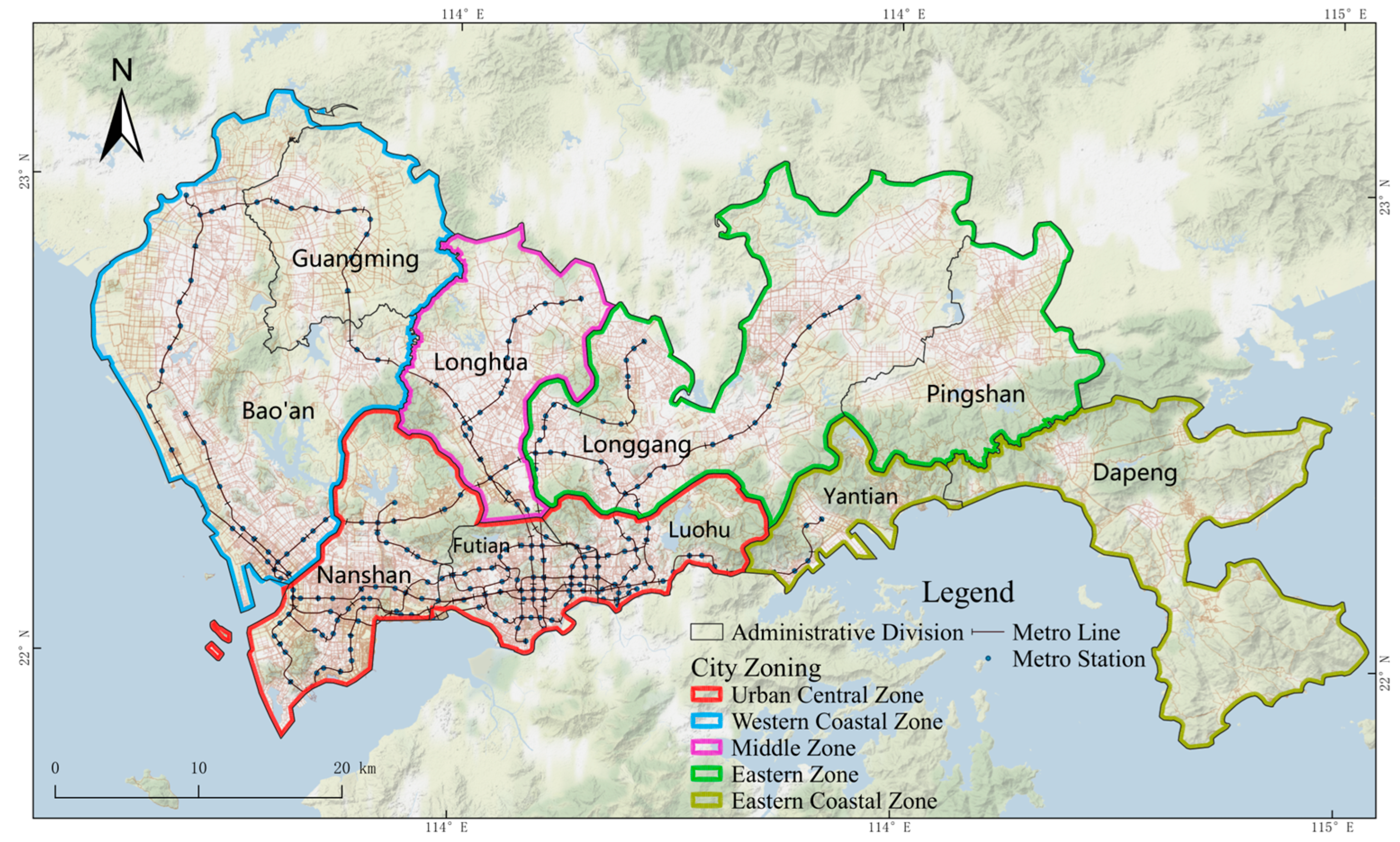
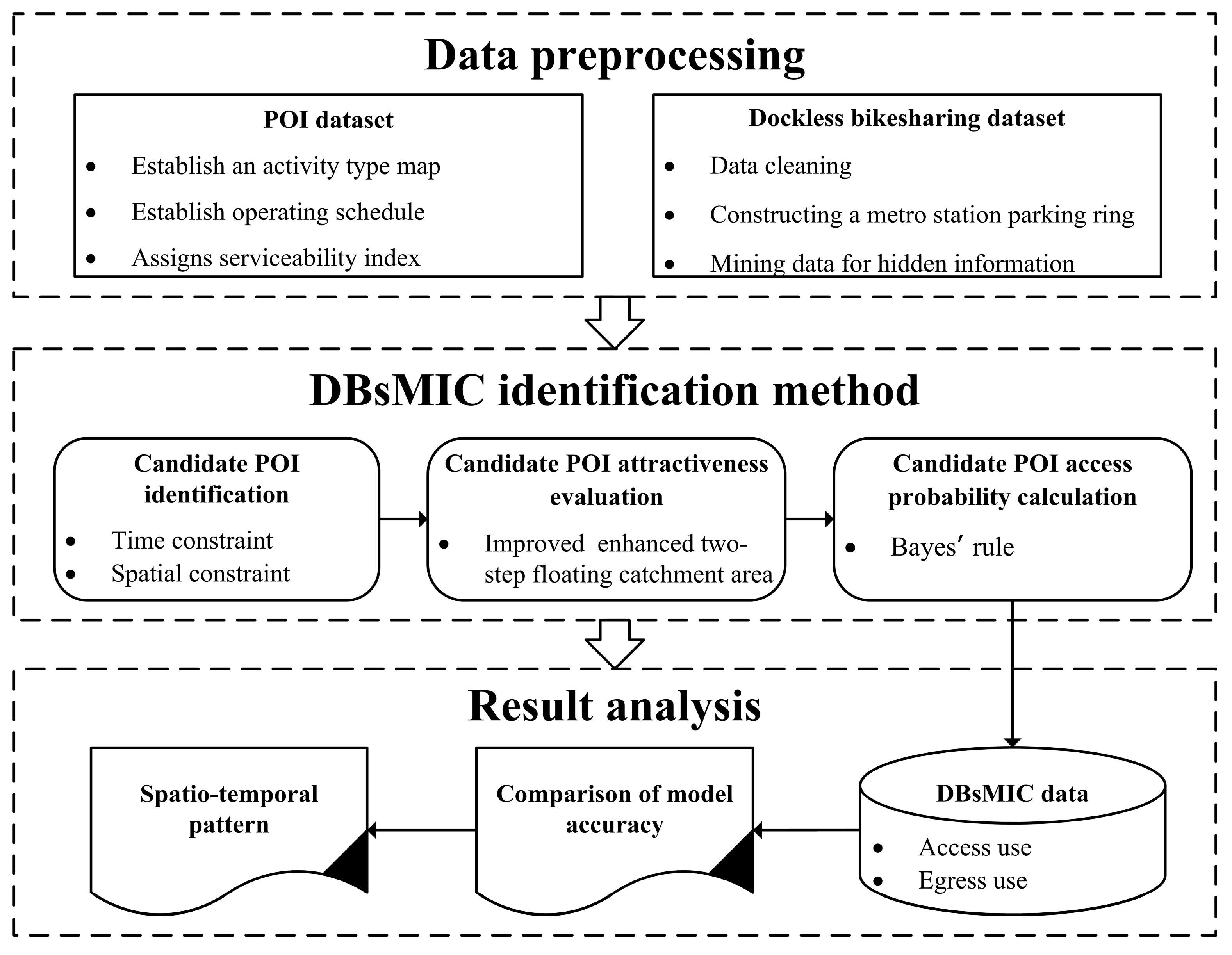
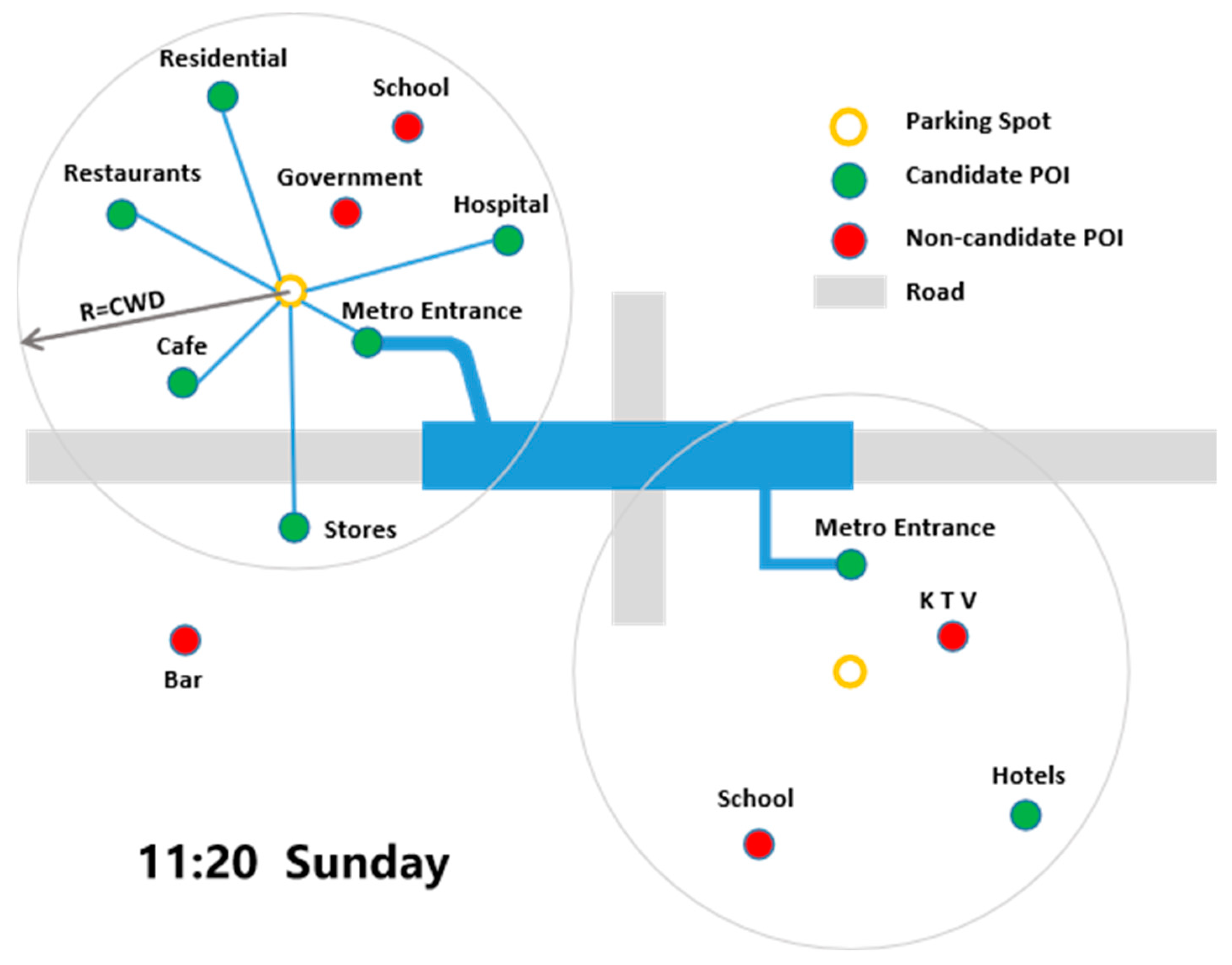

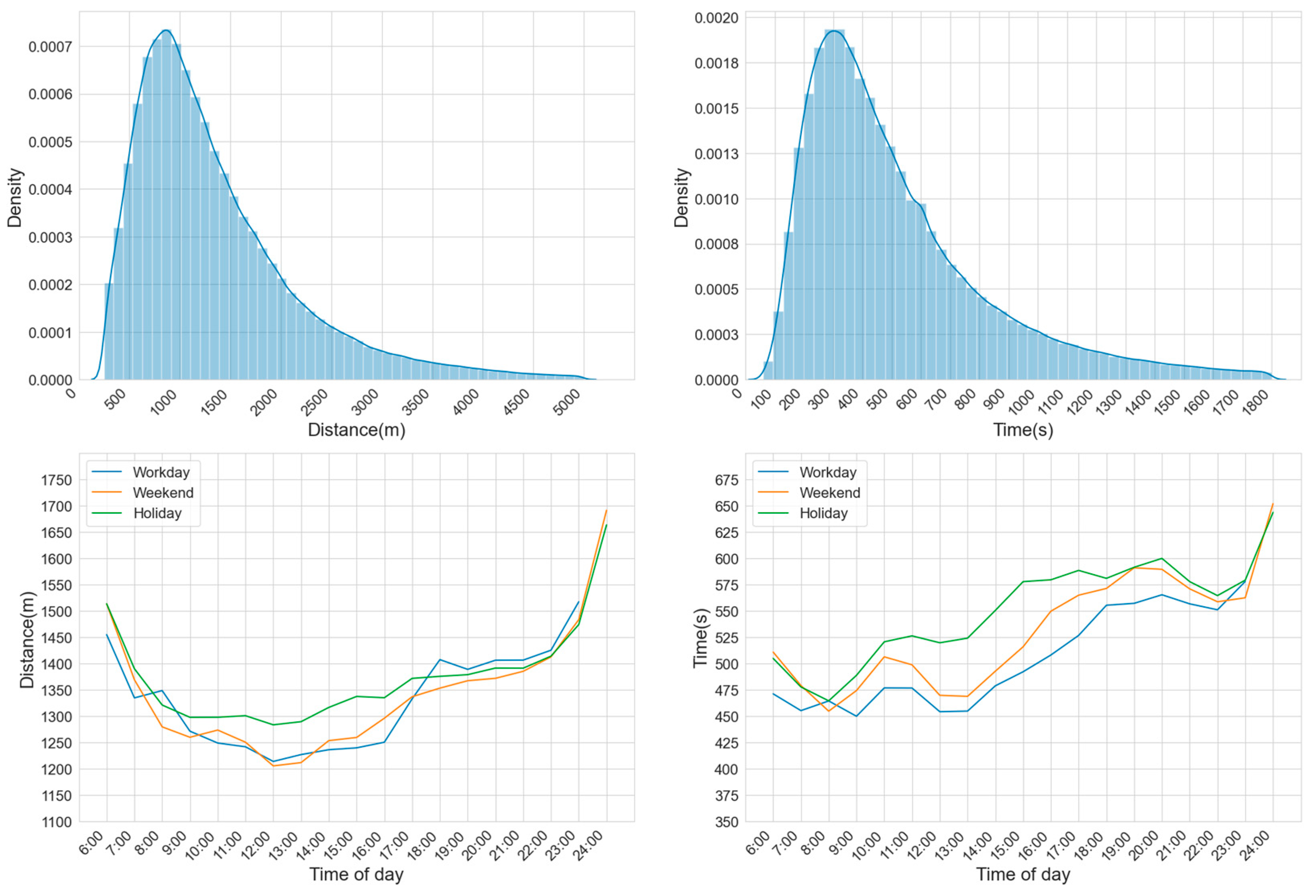

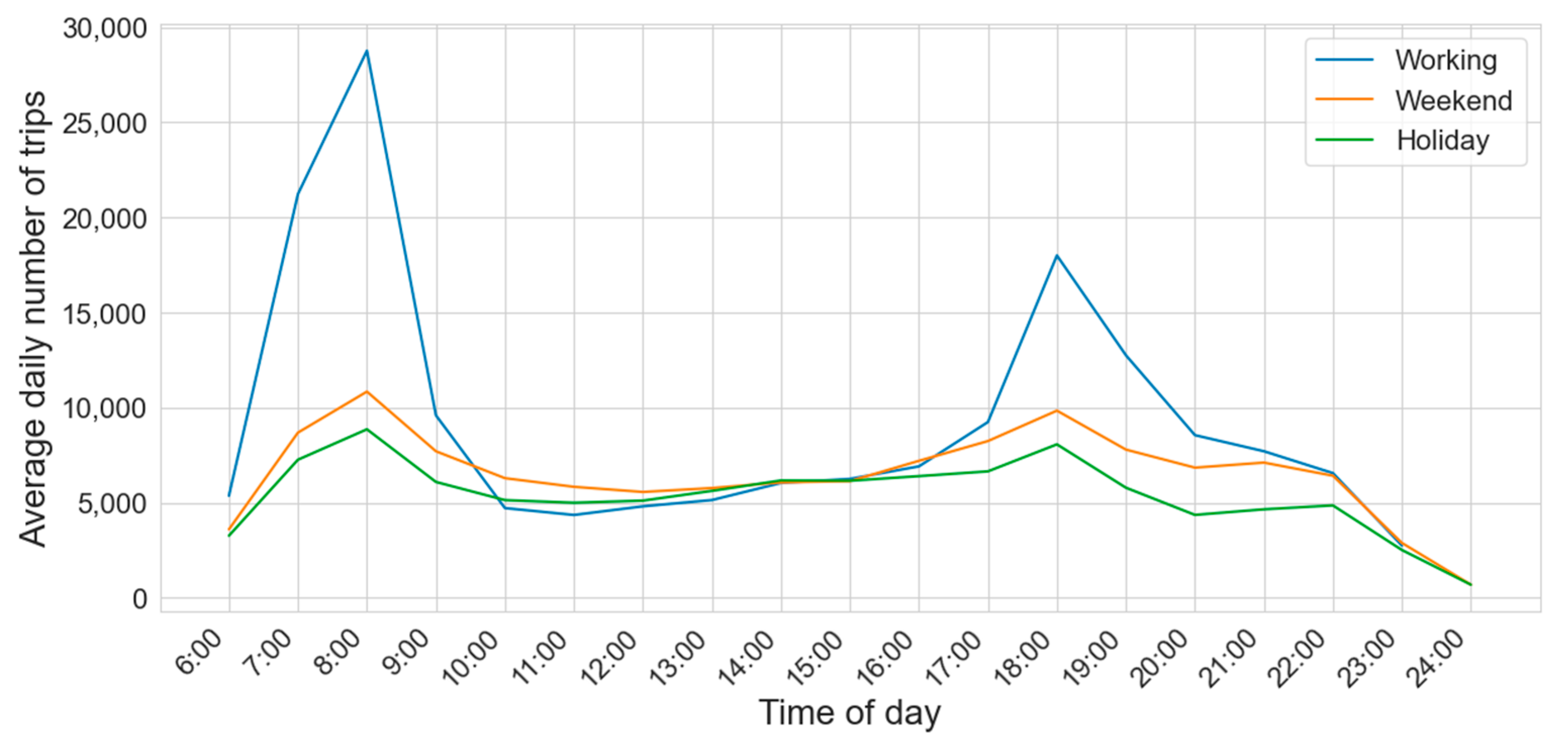
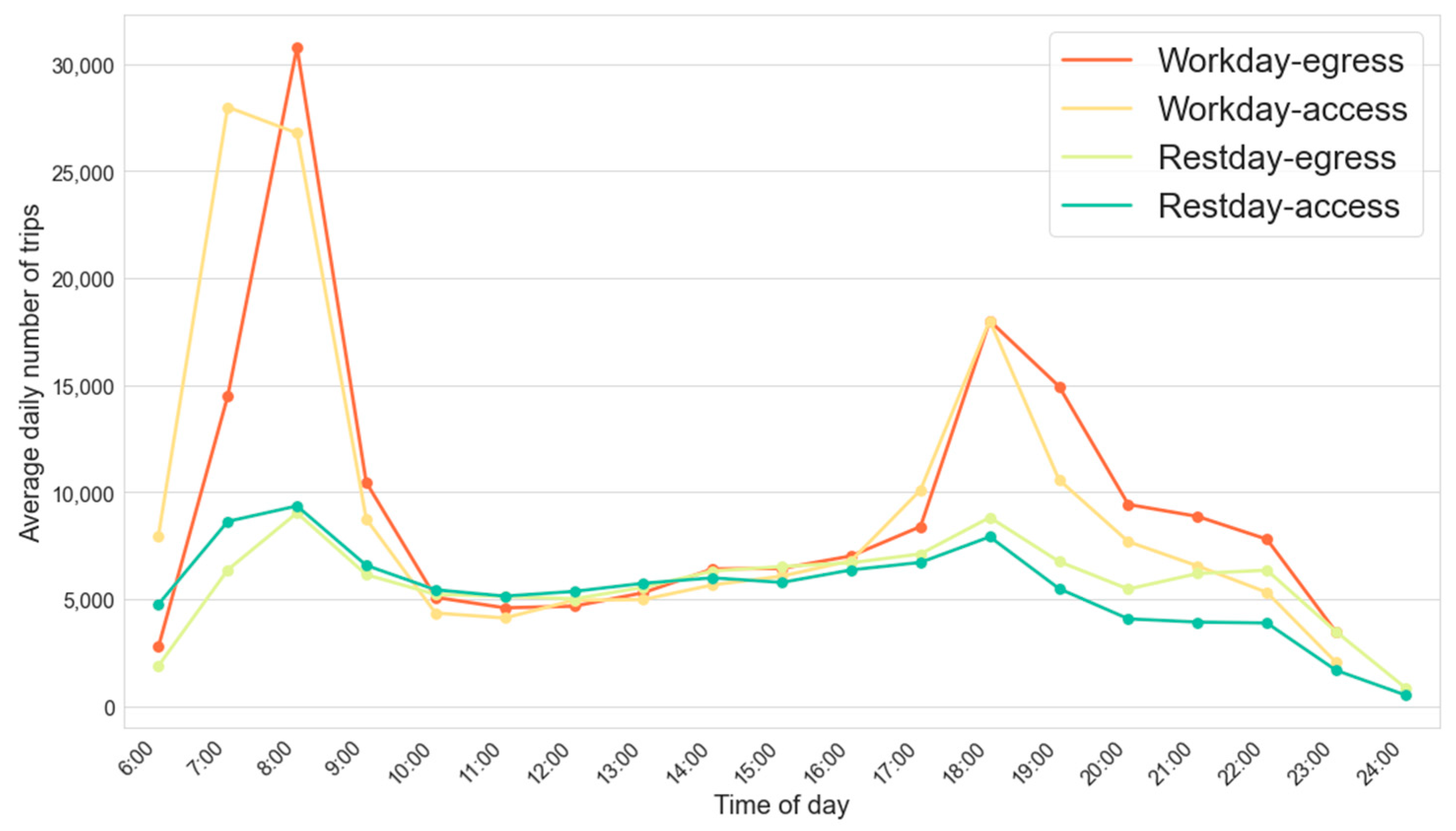
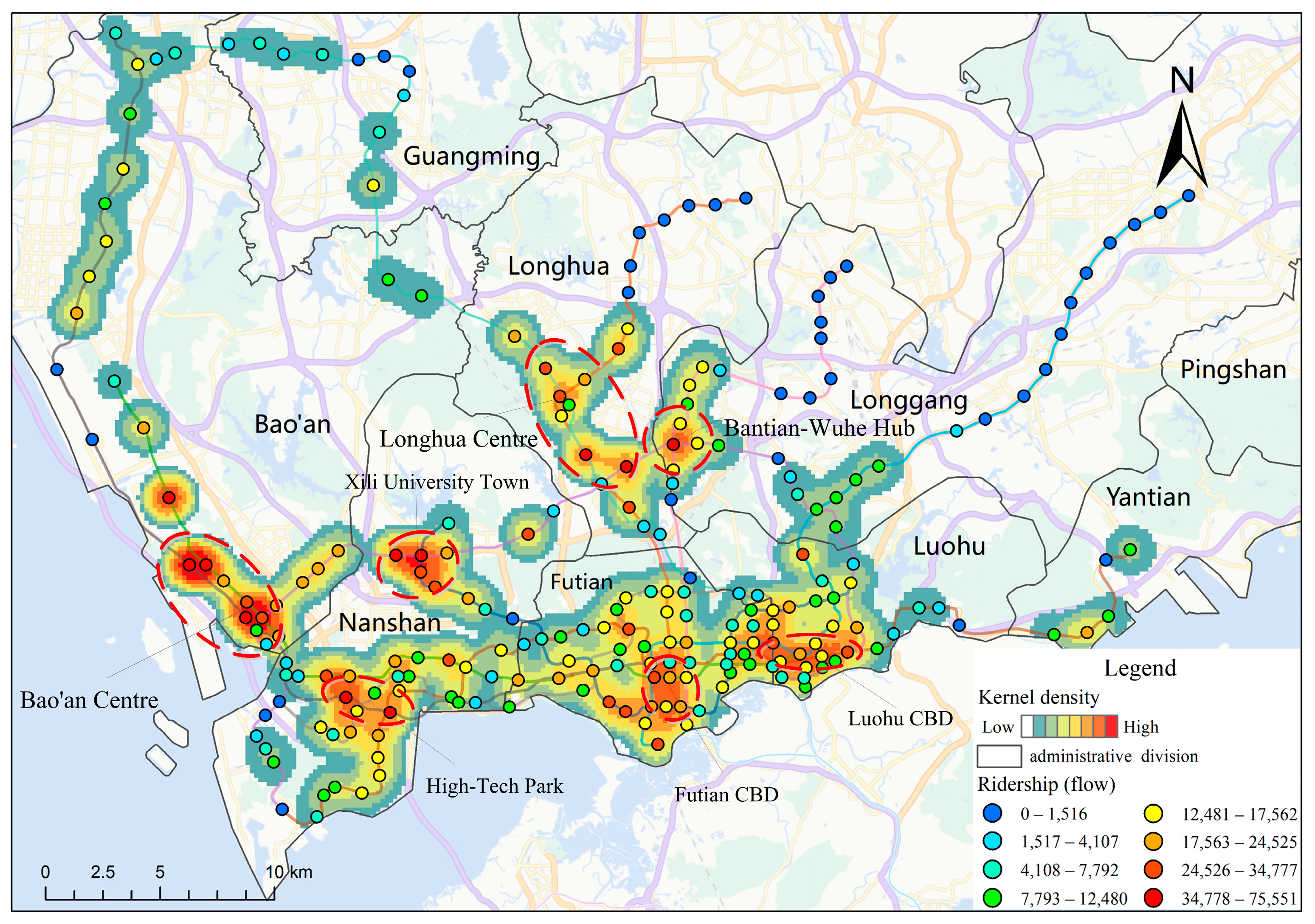
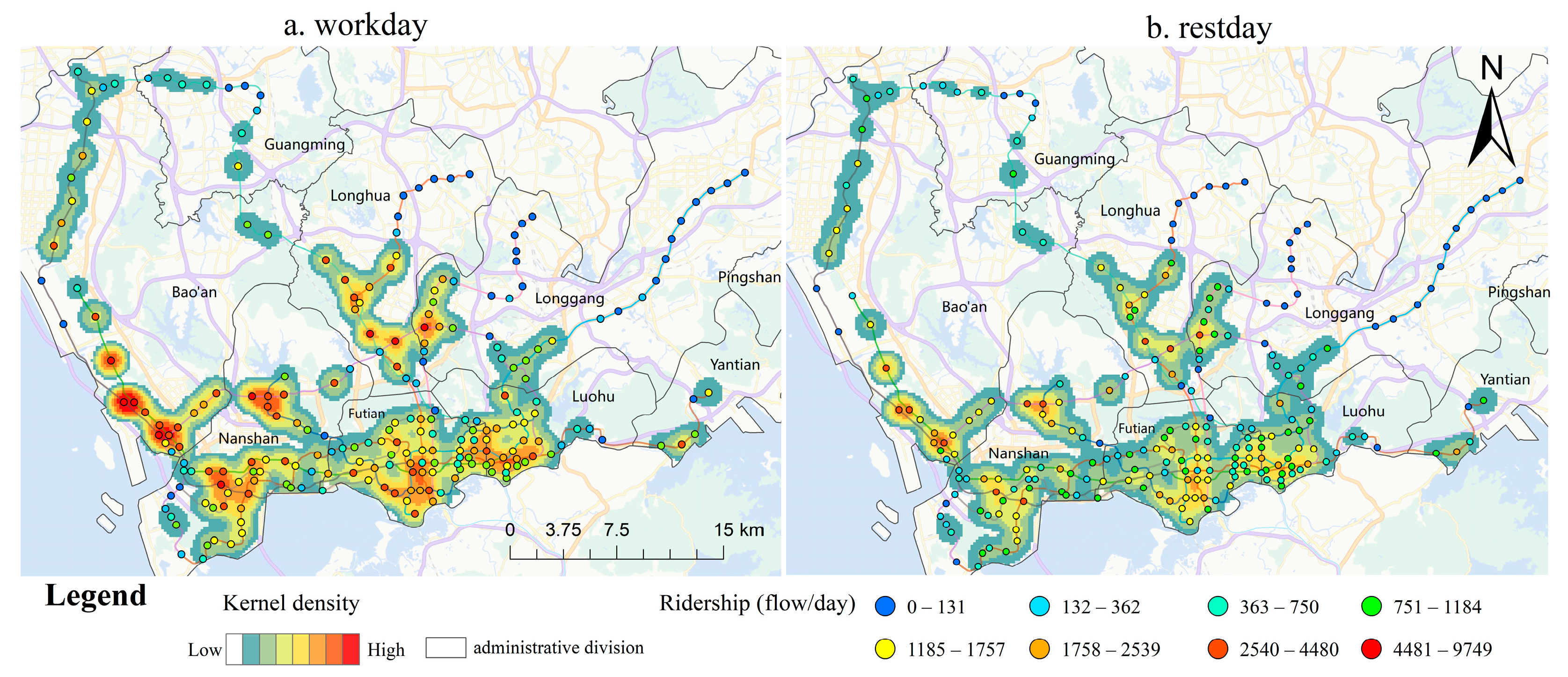


| Code | Type of Activity | Primary POI Categories | The Service Power Index | Workday Relevant Hours | Weekend Relevant Hours |
|---|---|---|---|---|---|
| 1 | Metro Services | Metro entrance | 2 | 6:00–24:00 | 6:00–0:30 |
| 2 | Home | Residential communities | 0.6 | 0:00–24:00 | 0:00–24:00 |
| Residential buildings | 0.46 | 0:00–24:00 | 0:00–24:00 | ||
| Hotels | 0.18 | 0:00–24:00 | 0:00–24:00 | ||
| 3 | Work | Media agencies, insurance companies, finance companies, securities companies, financial and insurance service providers | 0.59 | 8:00–22:00 | 8:00–18:00 |
| Large enterprises, general companies | 0.47 | 8:00–22:00 | 8:00–18:00 | ||
| Government, banks, social groups | 0.47 | 8:00–17:00 | Closed | ||
| Industrial Parks | 0.43 | 8:00–22:00 | 8:00–18:00 | ||
| Factory | 0.21 | 8:00–22:00 | 8:00–18:00 | ||
| 4 | Catering Services | Chinese restaurants, foreign restaurants | 0.43 | 11:00–14:00 | 11:00–14:00 |
| 17:00–21:00 | 17:00–21:00 | ||||
| Dessert, cold drink, pastry and other food, and beverage-related establishments | 0.18 | 9:00–22:00 | 9:00–22:00 | ||
| 5 | Shopping services | Shopping malls, shopping streets, general markets, supermarkets | 0.77 | 9:00–22:00 | 9:00–22:00 |
| Building materials market | 0.56 | 9:00–22:00 | 9:00–22:00 | ||
| Electronic shops, flower, bird and fish markets | 0.47 | 9:00–22:00 | 9:00–22:00 | ||
| Supermarkets, convenience stores, clothing, shoes, hats and leather goods stores, personal goods, cosmetics stores, exclusive stores, culture stores, sports stores | 0.3 | 9:00–22:00 | 9:00–22:00 | ||
| 6 | Life services | Telecommunications, electricity, water supply business halls, business halls, post offices | 0.47 | 8:00–17:00 | 8:00–17:00 |
| Logistics and express | 0.33 | 9:00–22:00 | 9:00–22:00 | ||
| Baby services, photography printing shops, laundry, travel agencies, beauty salons, car repair sales | 0.23 | 9:00–22:00 | 9:00–22:00 | ||
| 7 | Science, education, and cultural services | Universities, scientific research institutions, | 1 | 0:00–24:00 | 0:00–24:00 |
| libraries | 0.97 | 9:00–22:00 | 9:00–22:00 | ||
| Elementary school, junior high school, high school, kindergarten | 0.43 | 8:00–18:00 | Closed | ||
| Training institutions | 0.29 | 8:00–22:00 | 8:00–18:00 | ||
| Science and education places | 0.24 | 9:00–22:00 | 9:00–22:00 | ||
| 8 | Sports recreation | Parks, squares | 0.82 | 7:00–22:00 | 7:00–22:00 |
| Sports and leisure service venues | 0.81 | 9:00–22:00 | 9:00–22:00 | ||
| Bar, disco, KTV | 0.73 | 14:00–5:00 | 14:00–5:00 | ||
| Tourist attractions | 0.59 | 7:00–22:00 | 7:00–22:00 | ||
| Relaxation areas, bathing and massage facilities | 0.44 | 9:00–22:00 | 9:00–22:00 | ||
| 9 | Healthcare services | General hospitals, specialized hospitals, emergency centers | 0.65 | 0:00–24:00 | 0:00–24:00 |
| Disease prevention institutions, medical and health services, clinics, health and nursing shops | 0.31 | 9:00–22:00 | 9:00–22:00 | ||
| 10 | Transportation services (excluding subway) | Train stations, coach stations | 0.81 | 0:00–24:00 | 0:00–24:00 |
| Bus stops, other transportation-related places, ports, docks | 0.3 | 6:00–23:30 | 6:00–23:30 | ||
| 11 | Other | Public toilets, public telephones, ATM | 0.18 | 0:00–24:00 | 0:00–24:00 |
| Code | Activity Type | Percentage of POI for Activity Type | Method 1 | Method 2 | Method 3 | Method 4 (Method in This Paper) |
|---|---|---|---|---|---|---|
| 1 | Metro Services | 0.14 | 56.02 | 77.28 | 35.64 | 66.72 |
| 2 | Home | 4.92 | 5.42 | 2.47 | 12.81 | 6.64 |
| 3 | Work | 21.92 | 3.59 | 2.58 | 6.04 | 4.01 |
| 4 | Catering Services | 17.50 | 5.35 | 2.48 | 3.13 | 1.55 |
| 5 | Shopping services | 26.19 | 8.75 | 5.71 | 9.95 | 6.22 |
| 6 | Life services | 19.43 | 6.73 | 2.17 | 8.50 | 3.01 |
| 7 | Science, education, and cultural services | 4.34 | 3.31 | 1.52 | 3.59 | 1.87 |
| 8 | Sports recreation | 2.74 | 2.36 | 2.71 | 2.41 | 2.73 |
| 9 | Healthcare services | 1.07 | 2.42 | 1.56 | 3.78 | 3.17 |
| 10 | Transportation services (excluding subway) | 0.87 | 2.21 | 0.63 | 8.25 | 2.66 |
| 11 | Other | 0.87 | 3.66 | 0.89 | 5.90 | 1.42 |
| Number of Rides | Number of Users | Percentage(%) | Number of Rides | Number of Users | Percentage (%) |
| 1 | 446,376 | 45.69 | 6 | 34,728 | 3.56 |
| 2 | 179,345 | 18.36 | 7 | 25,737 | 2.63 |
| 3 | 94,188 | 9.64 | 8 | 19,749 | 2.02 |
| 4 | 65,763 | 6.73 | 9 | 14,678 | 1.50 |
| 5 | 47,341 | 4.85 | ≥10 | 49,091 | 5.02 |
| Total | 976,996 | ||||
Disclaimer/Publisher’s Note: The statements, opinions and data contained in all publications are solely those of the individual author(s) and contributor(s) and not of MDPI and/or the editor(s). MDPI and/or the editor(s) disclaim responsibility for any injury to people or property resulting from any ideas, methods, instructions or products referred to in the content. |
© 2023 by the authors. Licensee MDPI, Basel, Switzerland. This article is an open access article distributed under the terms and conditions of the Creative Commons Attribution (CC BY) license (https://creativecommons.org/licenses/by/4.0/).
Share and Cite
Wu, H.; Wang, Y.; Sun, Y.; Yin, D.; Li, Z.; Luo, X. Identification and Spatiotemporal Analysis of Bikesharing-Metro Integration Cycling. ISPRS Int. J. Geo-Inf. 2023, 12, 166. https://doi.org/10.3390/ijgi12040166
Wu H, Wang Y, Sun Y, Yin D, Li Z, Luo X. Identification and Spatiotemporal Analysis of Bikesharing-Metro Integration Cycling. ISPRS International Journal of Geo-Information. 2023; 12(4):166. https://doi.org/10.3390/ijgi12040166
Chicago/Turabian StyleWu, Hao, Yanhui Wang, Yuqing Sun, Duoduo Yin, Zhanxing Li, and Xiaoyue Luo. 2023. "Identification and Spatiotemporal Analysis of Bikesharing-Metro Integration Cycling" ISPRS International Journal of Geo-Information 12, no. 4: 166. https://doi.org/10.3390/ijgi12040166
APA StyleWu, H., Wang, Y., Sun, Y., Yin, D., Li, Z., & Luo, X. (2023). Identification and Spatiotemporal Analysis of Bikesharing-Metro Integration Cycling. ISPRS International Journal of Geo-Information, 12(4), 166. https://doi.org/10.3390/ijgi12040166






